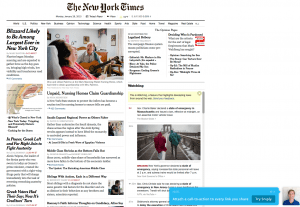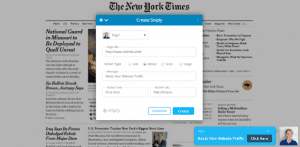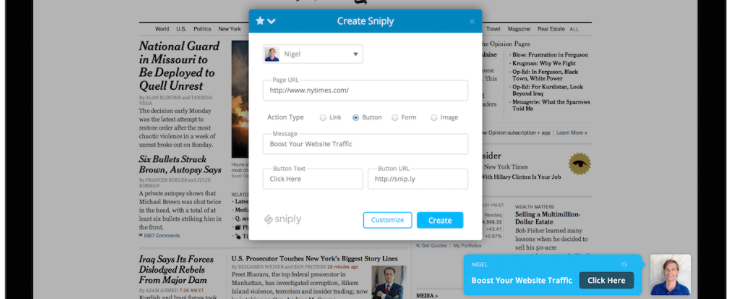Snip.ly: Putting Other People’s Ads on Your Site
 For as long as there has been social media, companies and webmasters have sought out ways to incentivize the sharing of content. This has included everything from free downloads to rewards programs from regular sharers.
For as long as there has been social media, companies and webmasters have sought out ways to incentivize the sharing of content. This has included everything from free downloads to rewards programs from regular sharers.
One company, however, may have pushed things a bit too far. In an effort to encourage the sharing of content on the Web, they are allowing users to place ads on all of the sites they share, including yours.
The company, Snip.ly, does this by using a frame to overlay content from the person sharing your site on top of your page.
The result is that, the next time you see your site shared on Twitter, Facebook or even linked on another site, you might see more than your page. Instead, could also see an ad for another site, a signup form for another email newsletter or a download link for something you didn’t create.
While some webmasters will be fine with this, others will not. If you’re in the latter category, there currently is no easy way to opt out and the only solution available is to block your site from being viewed within frames.
It’s an inelegant solution, but one you may want to look into. To understand why we’ll take a closer look at Snip.ly and why its service will be controversial for many.
How Snip.ly Works
 Snip.ly, fundamentally, works like a URL shortener akin to Bit.ly and similar services. You simply paste a URL into it and it will give you a short URL that you can share on social media or link to elsewhere.
Snip.ly, fundamentally, works like a URL shortener akin to Bit.ly and similar services. You simply paste a URL into it and it will give you a short URL that you can share on social media or link to elsewhere.
However, where most URL shorteners simply redirect to the destination, Snip.ly redirects to a version of the page in a frame. Using that frame, it overlays a message from the sharer on top of it. The result is that any page shared through Snip.ly carried with it an ad from the sharer, one that’s placed directly on top of the original site.
The sharer, the Snip.ly customer, gets to determine what is in that ad and where it is located. Though most of the Snip.ly ads are bubbles in one of the four corners of the site, they can also be bars across either the top or the bottom.
The ad itself can include any text or link that the Snip.ly users wishes. It can offer free downloads/reports, direct visitors to another site or provide a form to sign up for a newsletter operated by the Snip.ly customer.
In short, for the cost of creating a URL and sharing it, the Snip.ly user is allowed to place an ad on your site (or almost any other site), cover up potentially important content and promote their products and services, regardless of whether or not you endorse them.
My Concerns with Snip.ly
 In the help files, Snip.ly says that there are no legal issues with using the service. However, that’s not necessarily true.
In the help files, Snip.ly says that there are no legal issues with using the service. However, that’s not necessarily true.
Framing is a very divisive issue. In 2009 the social news site Digg, then one of the most popular sites on the Web, began to use frames on all outbound links. Entitled DiggBar, webmasters decried the bar and eventually got them to stop.
Soon thereafter, Hootsuite ran into a similar controversy of the use of frame in its ow.ly URL shortener, which it too had to back away from (at least in large part).
Legally speaking, there are actually a lot of issues arising from framing, in particular as Snip.ly performs it. They include (but are not limited to):
- Trademark Infringement: If users are led to believe that the the site endorsed or had a relationship with the Snip.ly user that didn’t exist, it could create a trademark issue.
- Copyright Infringement: It could be argued the Snip.ly creates a derivative work based on the original site, creating a copyright infringement.
- Misappropriation: By using the name, likeness and other elements of a person in a way they don’t permit, framing could give rise to a misappropriation claim.
All of these legal issues (and more) came up in the case The Washington Post v. TotalNews. In that case, Total News was using frames to display their logo and ads above content provided by The Washington Post (and other news sources). The case, however, was settled out of court before a ruling was handed down. In the settlement, TotalNews agreed to cease all framing activities and, instead, only link to the news stories.
But while the legal issues surrounding Snip.ly are unsettled at best, it’s the ethical issues I’m more concerned with.
With Snip.ly, it’s possible for someone to run an ad on any site they want without that webmaster’s permission. This means, for example, a smaller competitor can create links that run ads on their industry leader’s site, political sites can run ads over the sites of their opposition and so forth.
Through Snip.ly, it’s entirely possible that ads will appear on top of your site that you would never allow yourself including people, organizations, ideas you may find offensive. Unfortunately, there’s almost nothing you can do about it as Snip.ly does not provide a way to opt out, block ads from specific customers or in any way restrict how the service is used on your site.
The one thing Snip.ly does get very right is search engine optimization. Snip.ly works to ensure that all Google and other search engine benefit from the linking goes to the site being linked. Through the use of Canonical Headers, Snip.ly ensures that search engines know the original site is that one to be credited, not the Snip.ly URL.
Still, my concerns about the service are many. So I reached out to Snip.ly about them and received a quick response.
Snip.ly’s Response
When I reached out to Snip.ly, their first priority was to ensure that I understood that their intentions were and are good with the service. They directed me to this link that shows how they are working with publishers and feel that their service provides real benefit to content creators.
Basically, according to Snip.ly, they are working to provide an incentive for sharing and, in doing so, are hoping to get content more exposure. In their email, they highlighted that they are working with major publications such as The Washington Post (the named plaintiff in the TotalNews case), Globe and Mail and more.
They distinguished themselves from DiggBar and Hootsuite’s past efforts by saying:
“The reason why DiggBar is bad for the internet is because it promotes Digg. Hootsuite faced similar backlash. This is because they used framing to promote their own brand and nobody wants that.”
They went on to say that they are promoting the sharer and the sharer alone.
While that is largely true, it’s worth noting that, on every Snip.ly page, there is a small Snip.ly logo. Only users with Business accounts, the highest tier, can remove the logo from their Snip.ly URLs.
However, I don’t see a significant difference between advertising for Digg and advertising for a stranger, in particular one who may be a competitor, ideological opponent or someone I simply don’t wish to be associated with. In many ways, that could easily be worse.
Snip.ly also addressed the lack of an opt out saying saying:
“We are absolutely open to offering an easy opt-out method. In fact, it’s actually on our to-do list. Users who are uncomfortable with Sniply functioning on their site should be able to opt-out easily. However, given we’re a small team working on a big project, this has admittedly been delayed.”
However, this lack of time hasn’t stopped Snip.ly from launching dozens of integrations and extensions for all of the major browsers.
While they may agree that an opt out is something they should do, it clearly has not been a priority for them, though that may change now.
Blocking Snip.ly (And Others)
In the meantime, if you’re not comfortable with the way that Snip.ly uses your site’s content, your options for blocking it are fairly limited. Most of them center around either blocking your site from being viewed in frames or “breaking” the frame itself.
While there are many options for doing this, the three main ones are as follows:
- X-Frame-Options Header: The X-Frame Option Header was originally developed by Microsoft for IE8 but has since become accepted by most browsers. It instructs the browser to not display the page content if it is within a frame. However, you have to remember that this is NOT an HTML header, it is an HTTP header, meaning that you’ll likely want to use a WordPress plugin to help you set it up if you aren’t comfortable messing with such headers.
- JavaScript: Though JavaScript frame breakers can be beaten, Snip.ly says they will make no such attempts. Unlike the HTTP header, this is something you can just paste into your site’s source code and know you’ve blocked most attempts to frame your site.
- Referrer Blocking: Finally, it’s also possible to block Snip.ly, and other sites, from linking to you through the use of HTTP referrer blocking. While this involves editing the .htaccess file on a server, it’s much easier to do than the HTTP header. However, bear in mind this isn’t complete protection as some browsers don’t pass along this information, meaning it won’t block 100% of all users.
Of the three options, the first is clearly the best. It doesn’t require JavaScript, it works in nearly all popular browsers IE6/7 being the exception, and can’t be defeated by those putting your sites in frames, at least not trivially.
However, it is more complicated to set up and those who don’t host their own sites, such as those using Tumblr, BlogSpot, WordPress.com, etc., can’t make use of that technique (in fact, they may have limited access to any of these techniques).
As such, where possible I recommend using a combination of the HTTP header and the JavaScript (to catch the browsers that don’t comply with the header). In cases where the header can’t be applied, the JavaScript is probably the best bet.
While it might not stop the next company to come along, it will prevent Snip.ly from using your site.
However, there seems to be little reason webmasters should be required to go through this headache just to prevent other people from displaying ads on their site.
Bottom Line
To be clear about this, I don’t think Snip.ly is an evil company. I don’t think they built a product with the mindset that they were going to harm content creators and I believe them when they say that their goal is to support publishers.
However, like a lot of tech companies, I think they made the misstep of not considering how their product could be abused and the reasons some might object to it. They had an idea and jumped on it, not fully weighing all of the unintended consequences.
A system such as Snip.ly should be opt-in, not opt-out. However, as of right now, Snip.ly doesn’t even offer a true opt-out system, just a promise not to attempt to circumvent frame breaking technology.
But even if Snip.ly is able to right its ship and mitigate these issues, it won’t be the last company to attempt this. As Digg, Hootsuite and others have shown, companies, large and small, will go to great lengths to show their ads on and around your site without your permission.
The best you can do is be proactive and block that form of framing now, before someone more nefarious comes along.
Want to Reuse or Republish this Content?
If you want to feature this article in your site, classroom or elsewhere, just let us know! We usually grant permission within 24 hours.
